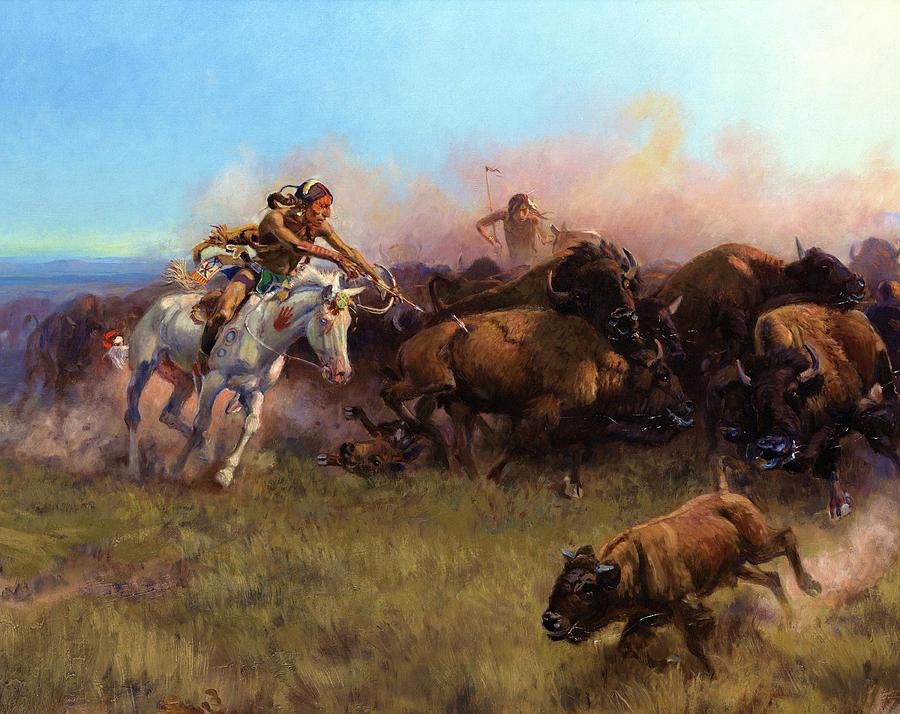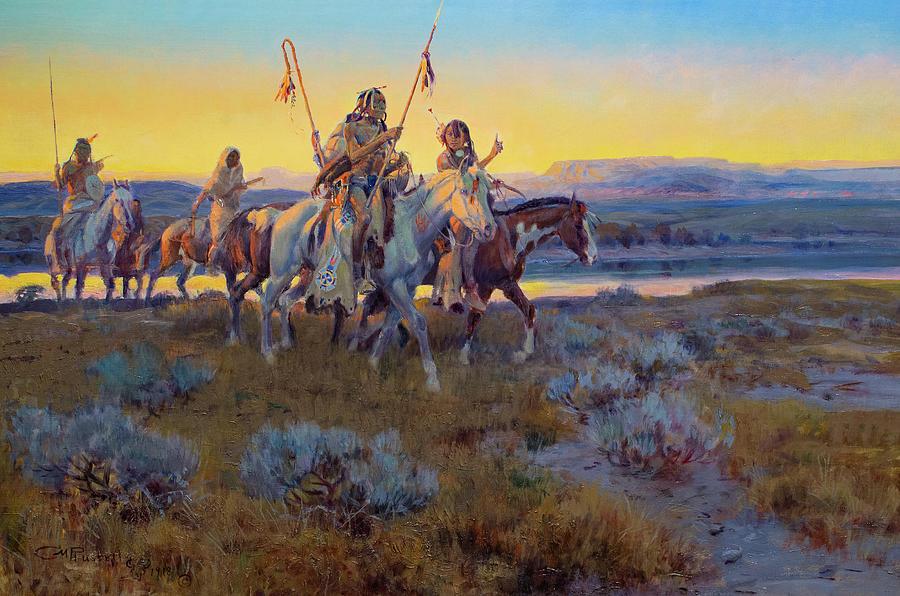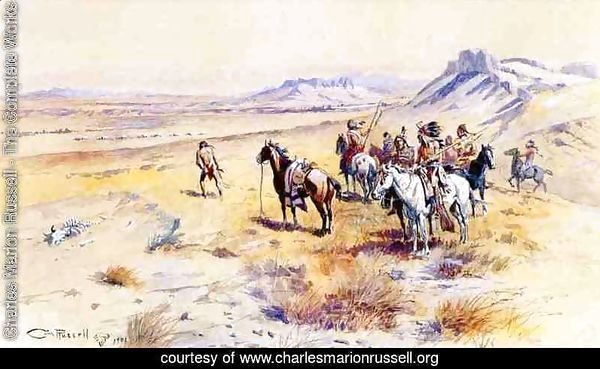The Western Landscape as a Spiritual Space
The Western landscape has long been a source of inspiration and spirituality for many people, including artists like Charles Marion Russell. For Russell, the Western landscape was not just a backdrop for his paintings, but a spiritual space that he sought to capture and convey in his art.
In many of Russell’s paintings, the Western landscape is depicted as a vast, awe-inspiring space that is both beautiful and intimidating. His use of color and light captures the changing moods of the landscape, from the golden hues of the prairie to the deep blues of the mountains. In his paintings, the landscape is not just a physical space, but a spiritual realm that connects people to nature and to something greater than themselves.
One of the ways that Russell conveyed the spiritual nature of the Western landscape was through his use of symbolism. In many of his paintings, he included elements that were imbued with spiritual meaning, such as the eagle, which represents strength and freedom, or the buffalo, which symbolizes abundance and the interconnectedness of all things.
Russell’s paintings also convey a sense of the sacredness of the land. In his depictions of Native American life, for example, he often showed people engaged in rituals and ceremonies that honored the land and its natural resources. In one of his most famous paintings, “Indian War Party,” he depicts a group of Native American warriors on horseback riding through a landscape that is both majestic and sacred.
For Russell, the Western landscape was not just a physical space, but a spiritual space that connected people to their environment and to something greater than themselves. His paintings capture the awe-inspiring beauty and majesty of the Western landscape, while also conveying a sense of the spirituality that is inherent in this unique and special place.
Russell’s Use of Symbolism and Mythology in his Paintings
Charles Marion Russell was a master of Western art who had a unique ability to capture the spirit and essence of the American West through his paintings. One of the key features of his paintings was his use of symbolism and mythology to convey deeper meaning and messages.
Russell’s paintings were not just simple representations of the American West, but rather complex depictions that drew on a range of mythological and symbolic elements. He used these elements to convey themes such as the cycle of life and death, the interconnectedness of all things, and the importance of the natural world.

One of the most commonly used symbols in Russell’s paintings was the buffalo, which he often depicted as a powerful and majestic animal. The buffalo was a central figure in the life of the Plains Indians, who relied on it for food, clothing, and shelter. In Russell’s paintings, the buffalo often symbolized the interconnectedness of all things, and the importance of preserving the natural world.
Russell also frequently used the eagle as a symbol of strength and freedom. The eagle was a sacred animal for many Native American tribes, and its presence in Russell’s paintings served as a reminder of the importance of preserving the natural world and protecting the environment.
Another important element in Russell’s paintings was his use of mythology, particularly the myths and legends of the Native American tribes of the West. In many of his paintings, he depicted scenes from Native American mythology, such as the creation story, the hero’s journey, and the cycle of life and death.
Russell’s paintings often conveyed a sense of reverence for the natural world and the spiritual connection between humans and nature. He believed that the American West was a place of great spiritual significance, and his use of symbolism and mythology helped to convey this message to his audience.
In addition to his use of symbolism and mythology, Russell was also known for his unique style and technique as a painter. He used bold colors and strong, sweeping brushstrokes to create a sense of movement and energy in his paintings, which helped to convey the power and majesty of the American West.
The Role of Religion and Spirituality in Russell’s Life and Art

Religion and spirituality played a significant role in the life and art of Charles Marion Russell. Born in 1864 in St. Louis, Missouri, Russell grew up in a family that valued religion and attended church regularly. As a young man, he worked as a cowboy in Montana and had a deep appreciation for the natural world and the spirituality of the Plains Indians.
Russell’s interest in Native American spirituality is evident in many of his paintings, which often depict scenes from Native American mythology and use symbolism to convey spiritual themes. He believed that the American West was a place of great spiritual significance and felt a deep connection to the land and its people.
Russell’s spirituality also played a role in his personal life. He was married to his wife Nancy Cooper in a Catholic ceremony in 1896, and the couple remained devoted to their faith throughout their lives. Russell’s religious beliefs were also reflected in his art, with many of his paintings depicting scenes from the Bible or incorporating religious imagery.
One of the most prominent examples of religion and spirituality in Russell’s art is his painting “Piegans,” which depicts a group of Native American men and women gathered around a campfire, praying and engaging in a spiritual ritual. The painting is a powerful example of Russell’s ability to capture the spiritual essence of the American West and convey it through his art.
Another example of the role of religion in Russell’s life and art is his painting “The Last Supper,” which depicts the Biblical scene of Jesus and his disciples sharing a meal before his crucifixion. The painting is notable for its use of Native American models, who are depicted as the disciples in the scene.
Throughout his life, Russell remained deeply connected to his spirituality and used it as a source of inspiration in his art. He believed that art had the power to convey deeper truths and messages, and he used his paintings to explore spiritual themes and convey his own personal beliefs.
Conclusion
the art of Charles Marion Russell is a testament to his unique spiritual vision and his ability to capture the essence of the American West. Russell’s deep appreciation for the spirituality of the West and its Native American peoples is evident in many of his paintings, which use symbolism and mythology to convey spiritual themes.
Russell’s use of symbolism and his ability to capture the spiritual essence of the West are particularly evident in his depiction of landscapes. He believed that the Western landscape was a spiritual space that reflected the divine, and he often incorporated elements of nature into his paintings to convey this spiritual message.
Russell’s paintings also reflect his belief in the interconnectedness of all things. He believed that everything in the natural world was connected, and that humans were just one part of a larger spiritual whole. This belief is evident in many of his paintings, which often depict humans and animals living in harmony and connected to the natural world.
Overall, Russell’s spiritual vision and his ability to convey it through his art have left a lasting impact on the art world and on our understanding of the American West. His paintings capture not only the physical landscape but also the spiritual essence of the West and the people who inhabited it.
Through his paintings, Russell has given us a glimpse into a world that is both mystical and deeply connected to the natural world. His art challenges us to see beyond the surface and to recognize the spiritual dimension of the world around us. In this way, Russell’s art continues to inspire and inform our understanding of the American West and its spiritual significance.














Comments